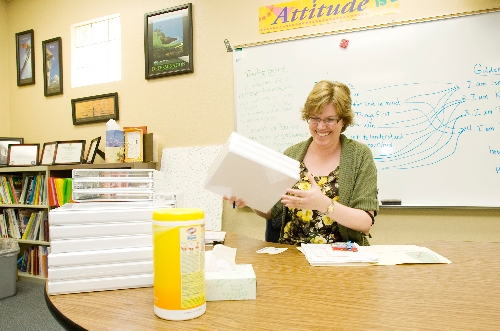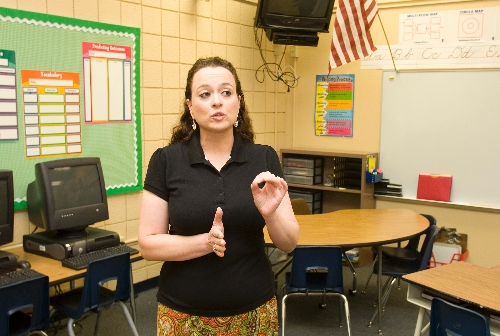School district meets federal requirements in No Child Left Behind law
Despite higher academic targets and a growing population of students living in poverty, the Clark County School District as a whole achieved the 2009-10 benchmarks of No Child Left Behind, the federal school accountability law, officials announced Thursday.
But not all the news is good: More than half of the district's individual campuses failed to make adequate yearly progress, or AYP. A school's standing is based on the assessment of numerous factors, including basic skills testing, student attendance, and graduation rates.
The district's breakdown showed that 215 schools fell short of federal achievement benchmarks and that 152 schools met them.
No Child Left Behind requires public schools to have all students reading, writing and performing mathematics at grade level by 2013-14.
Sixty-seven district schools fell short in just one or two of the numerous categories used to determine adequate yearly progress. Another 25 schools made sufficient gains last school year but must do so again this year to earn "adequate yearly progress" standing.
As a whole, the district met federal benchmarks in 92 percent of academic, attendance and graduation categories. Superintendent Walt Rulffes, who intends to retire as soon as the district hires his successor, was pleased.
"There couldn't be a better going away present than to make (adequate yearly progress)," Rulffes said.
He noted that the district as a whole has made adequate yearly progress in three of the past four years, which is "something to be envied by every district in the country."
Progress has been made even though the percentage of district students qualifying for free and reduced lunch increased from 30 percent in 2005, to more than 50 percent in 2010, Rulffes said.
District officials say much progress has been made since the 2002-03 school year, the first year No Child Left Behind was implemented.
Elementary student proficiency rates in math improved from 49.5 percent in 2002-03, to 66.5 percent in 2009-10. High school student proficiency rates in math increased from 52 percent to 72.5 percent in the same period.
Because the ultimate goal is 100 percent proficiency, the federal target establishing what percentage of students must pass the state's standardized tests keeps changing. Last year, the benchmarks increased 10 percentage points, to levels in the mid-60s and mid-80s percent range.
Schools are also required to show student progress in five different ethnic subgroups, in special education, in low-income groups and among those with limited English skills. All eight subgroups must show progress for a school to make adequate yearly progress.
"It's like if you're measuring a family," Rulffes said. "If one kid gets in trouble, the whole family doesn't make it."
Schools that fall short are deemed as "needing improvement." Students also are given options to transfer to better performing schools.
After the sixth consecutive year of needing improvement, "something at the school has to change," Rulffes said. That might include changing the staff, the curriculum or letting the state take over. Rulffes said district officials will meet in the next few weeks to discuss appropriate measures at poor performing schools.
The district has 60 schools that have never been designated as adequate, including campuses that opened after the federal law was enacted.
When the district is judged as a whole, the standards are not as stringent. The district can be deemed in compliance by meeting academic and attendance standards at the elementary, middle or high school levels.
"(For example), in English language arts, there are elementary, middle and high school designations," said Jeffrey Halsell, the district's testing coordinator.
"If the district makes it in any of the three categories, then the district makes the AYP designation," Halsell said. "By federal law, that's how districts are designated."
This year, the district's high schools, as a group, met the standards for math and English language arts.
Because the elementary and middle school groups met the benchmarks for daily attendance, the district did not have to meet the federal benchmark for high school graduation rates, which has gone from 50 percent to 85 percent. The district's graduation rate was just 68 percent in 2008-09.
District officials were eager to share success stories.
Henderson's Gibson Elementary School made adequate yearly progress for the eighth consecutive year.
School officials attributed achievement to the personal attention they give to their 500 students. Reading skills are tested at the beginning of the school year. Those who are "below benchmark" are given extra reading instruction.
"Thirty minutes extra, every single day," said Debbie Goodman, the school's guidance counselor. "Their progress is monitored every two weeks so we can track. We actually graph out their progress."
Lisa Medina, who has been Gibson's principal for seven years, also said good morale and low staff turnover contributed to the school's success.
"We have cultivated a positive climate," said Medina, who has the words, "Live, laugh, love" posted above her desk. "We retain and sustain a positive energy in our building with a focus on teaching and learning and doing what's best for kids."
Clark High School, on Pennwood Avenue east of Arville Street, shed its "needs improvement" designation within the past three years to become an exemplary turnaround school.
"We're going to return to school in a very celebratory mode," said Clark Principal Jill Pendleton.
School begins Aug. 30 for district students.
Contact reporter James Haug at jhaug @reviewjournal.com or 702-374-7917.
2009-10 CCSD Adequate Yearly Progress Report
No Child Left Behind 2009-10 Exemplary and High-Achieving Schools


















